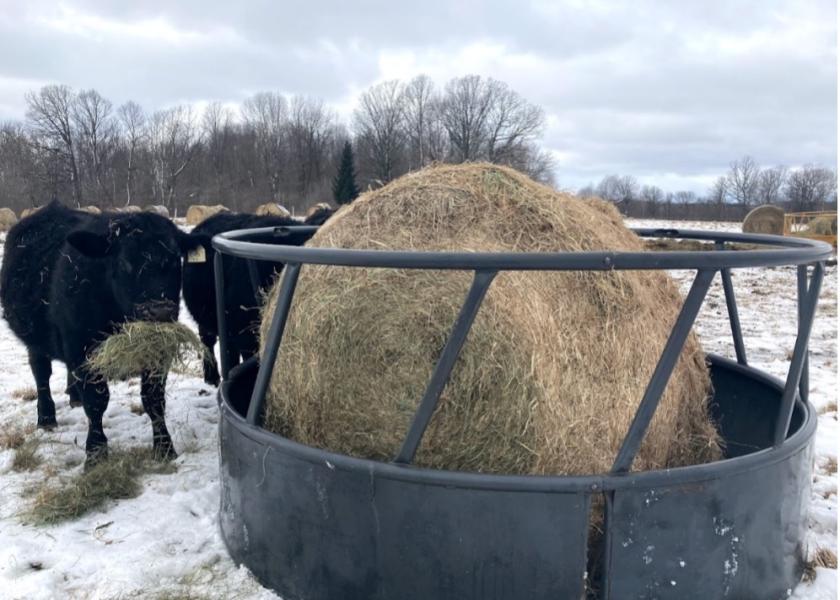Bale Grazing: Enhance Soil Health and Forage Production Through Innovative Hay-Feeding

For ranchers during the winter months, minimizing or eliminating hay usage through efficient grazing management could be an effective way to improve the bottom line. Additionally,ranchers with a regenerative mindeset may also find hay feeding as a valuable tool, especially when aiming to revitalize soil health in severely depleted areas.
Bale grazing proves effective in promoting soil health for various reasons, says Hugh Aljoe in an article originally published by the Noble Research Institute. While every ranch and grazing plan is unique, here are a few considerations and tips to help you determine if bale grazing is right for your operation.
What is Bale Grazing?
In bale grazing, bales are placed on pasture, often pre-set in a grid pattern prior to winter, explains Jason Cavadini and Michael Geissinger in a University of Wisconsin-Madison article. A temporary electric fence wire is used to limit access to only a few bales at a time, which are often (not always) fed using bale rings.
Throughout the winter grazing period, the bales are kept stationary while livestock are progressively moved through the grid by moving the wire and bale ring. Cavadini and Geissinger note that this strategy of feeding hay is an effective way to outwinter several breeds of livestock – predominantly cattle – while also distributing nutrients, building soil fertility and reducing the costs of inputs and labor.
Selecting Locations for Bale Grazing and Hay Feeding
The practice of bale grazing may be valueable on sites with low nutrient levels that would benefit from the organic matter and nutrients provided by hay feeding. Optimal results are achieved in areas that should be productive but have been neglected or are severely depleted.
Additioanlly, target well-drained locations, especially in regions prone to winter wetness, such as sandy or rocky soils. While these areas may not be highly productive, they often feature bare ground, facilitating cattle movement during wet spells and allowing simultaneous improvement of soil health.
In exceptionally dry years, leverage bale grazing to encourage cattle to utilize less-grazed portions of pastures, promoting even forage distribution and utilization.
Lastly, identify locations where close monitoring of bred heifers or growing animals is necessary during adverse weather conditions or suboptimal grazing conditions, and plan bale grazing accordingly.
Planning and Pre-Positioning Hay
Anticipate hay feeding needs based on your growing season, soil improvement goals or potential inclement weather, and plan and place hay in advance. This proactive approach, known as "in-place" hay feeding, involves setting up feeding areas early and avoiding their use until the winter feeding season.
Space large round bales in a checkerboard pattern, typically 30 to 40 feet apart, in the designated area. Use temporary electric fences to allocate hay for short periods during the bale grazing season.
Consider using lower-quality hay for in-place hay feeding, as it serves multiple purposes, including rumen fill, providing organic matter to the soil, and concentrating manure and urine deposits for improved soil nutrient content.
For higher-quality hay, consider using a feeding ring for more efficient distribution, while still concentrating manure and urine in targeted areas.
In regions with dry climates and snow cover, explore windrow grazing as an in-place hay feeding strategy. Cut and windrow the last hay cutting before winter, and allocate portions to the herd as needed during the hay feeding season.
Benefits to Soil Health and Future Growing Seasons
Bale grazing in multiple strategic locations during winter yields benefits such as nutrient and organic matter input from hay, improved water infiltration, soil cover, and enhanced plant and organism growth in the subsequent growing season.
To avoid nutrient buildup, rotate bale grazing sites and refrain from using the same area repeatedly. Aim for a natural cycle where plant growth is facilitated, contributing to a functional ecosystem with energy flow, water cycle, nutrient cycle, and community dynamics working harmoniously.
In areas with sparse ground cover, cattle hoof action during bale grazing stimulates ecosystem dynamics, incorporating deposited nutrients into the soil. This enhances biotic activity in the spring, fostering new plant growth.
Cautionary Considerations
Avoid using bale grazing as a substitute for feed to increase carrying capacity, as it can incur economic costs in terms of time, effort and equipment maintenance.
Excess hay residue in fertile areas may temporarily impede early forage production, but it can lead to robust growth later in the growing season, especially in thin forage stands.
Be cautious about introducing non-native grasses and undesirable plants into native pastures through bale grazing. If practicing bale grazing in a native forage environment, opt for native-grass-type hay, preferably sourced locally from a known supplier.
Conduct a thorough cost-benefit analysis to determine if bale grazing aligns with your ranch's objectives in improving soil health and forage production. If your hay matches your forage system and you have sites requiring additional organic matter and nutrients, consider implementing bale grazing as a viable strategy.
Bale grazing, when strategically implemented, can be a valuable tool for ranchers aiming to enhance soil health and forage production while decreasing labor costs and minimizing wear and tear on facilties and eqiupment during the winter months. Be sure to tailor these practices to your specific ranching needs to maximize the benefits while avoiding potential pitfalls.







